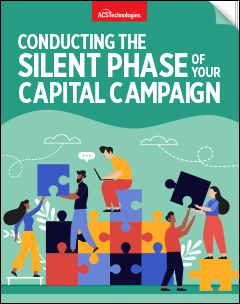From the series, Conducting the Silent Phase of Your Capital Campaign.
Most organizations rush into capital campaigns. And it’s understandable – we have a desperate need for a new space, program, staff position, a vehicle, a building. But successful campaigns are well planned, and the silent phase is critical. In this first blog of the series we cover getting input from your key donors.
What do we mean by a “silent phase”? This period of time is our opportunity to quietly explore the potential campaign project with our donor base. No one yet knows we’re officially launching a capital campaign. No one knows what the goal might be or what the timing is. While it’s not a congregational secret, we’re looking at a project or campaign options. This is a quiet time for us to assess our plans, the timing, donor capacity, and overall project scope.
I see many organizations rush into architectural renderings or project drawings long before they’re ready to really define the project scope against their donor capacity. This is not the time to spend lots of time and money on construction estimates and blueprints.
In this blog series, we’ll walk through the components of the silent phase of a campaign. And how to best use this time to ensure your campaign’s ultimate success.
The first step in the silent phase is to get direct feedback from your key donors. You should be at a point now to be able to articulate to them the possible scope of your project and its need. Schedule individual meetings with your best givers. Discuss the project with them, honing in on what the church is trying to accomplish.
Your role in these meetings is primarily one of the neutral notetakers. How do they feel about the project and the need for it? How important is it? What are their thoughts about any projected timing or costs? How do they think other congregants and givers will respond?
Don’t try to “sell” them on the project or correct their thinking as you gather their input. Don’t be defensive. Just absorb the feedback and ask more questions. You’ll use this information to shape and inform your decision-making and your case for support going forward. Simply listen and gather the input from as many of your loyal and involved givers as you can. If these involved donors have an unclear picture of the need or the project, that will help you better understand the challenges – and opportunities – ahead.
Finally, record and reflect on the feedback from these sessions with your donors in this silent phase. The information will be central to your planning going forward.
In the next blog of this series, we’ll continue to unpack the steps in conducting a silent phase of a capital campaign…from research to your ask strategy. For more information on campaigns, giving, donors, etc., please visit Church Growth.
WHY STAY SILENT? CONDUCTING THE CRITICAL QUIET PHASE OF YOUR CAPITAL CAMPAIGN
Many capital campaigns fail, typically due to a lack of preparation.
In this article, discover the key components of the silent phase of a capital campaign. This is the phase that allows us to “stay under the radar” and do the critical assessments of our campaign readiness.
Learn about the steps in the quiet phase, from timing to developing a compelling ask, that will help ensure you’re positioned to launch a successful campaign.
Tim Smith has over 30 years of experience in Church, Non-Profit Administration, Management, and Fund Development. Serving as an Executive Pastor and Chief Development Officer in growing Churches and Non-Profit Organizations has provided a wide range of expertise and resources. Tim serves as Founder and CEO for Non-Profit DNA. A boutique firm committed to helping nonprofits and churches build their capacity through fundraising, leadership, team building, staff recruiting, and coaching.





